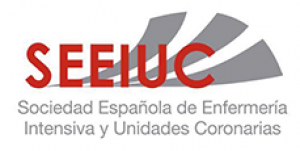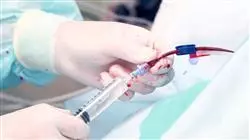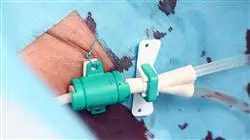University certificate
Scientific endorser

The world's largest faculty of nursing”
Introduction to the Program
The new scenarios in Intensive Care Units demand new update programs, adapted to the real needs of nursing professionals, so that they can incorporate the advances in critical patient care"

The provision of professional healthcare services within an Intensive Care Unit requires the acquisition of a highly specific set of knowledge and skills. Critical patient care is also one of the most specialized and evolving areas of the healthcare world. It is essential, therefore, that the nursing professional is able to respond adequately to these advances in scientific and technological knowledge by constantly updating their knowledge.
The content of this Professional master’s degree is focused on the detailed updating of nursing professionals for the provision of care in intensive care areas, whose functions require high levels of qualification. An the other hand, to initiate their activity as professionals in the field of research.
Only with an adequate, focused, and specialized updating program can the necessary knowledge and skills be acquired and maintained to respond to the needs of critically ill patients with criteria of efficiency, scientific rigor, and the highest professional level. The work of nurses in Intensive Care Units increasingly requires competent professionals with specialized Knowledge, so that they are able to respond to the care needs that society and the progress of medicine pose. This way, they will become familiar with a wide range of techniques and procedures and acquire the skills required for the assessment and care planning for critically ill patients. Specific care and assistance are indispensable and can only be provided by qualified and specialized professionals with specific knowledge and skills.
Thanks to this Professional master’s degree, graduates will complete their specialization in Intensive Care with an online methodology that will allow them to update their knowledge in the field, adapting their skills to their daily work.
Constant updating is key to providing specialized nursing care with maximum quality and safety required by the critically ill patient"
This Professional master’s degree in Intensive Care Nursing contains the most complete and up-to-date scientific program on the market. The most important features include:
- Development of more than 100 clinical cases presented by nursing professionals with expertise in intensive care and university professors with extensive experience in critical patients. The graphic, schematic, and practical contents with which they are created, provide scientific and practical information on the disciplines that are essential for professional practice
- Assessment and monitoring of the critically ill patient; the latest international recommendations on life support maneuvers; critical care in patients with neurological, cardiovascular and respiratory disorders; care of the severe trauma patient in intensive care; pharmacology and transport in the critically ill patient, etc.
- Comprehensive systematized action plans for the main pathologies in the Intensive Care Medicine Unit
- Presentation of practical workshops on procedures, diagnosis, and treatment techniques in critical patients
- An algorithm-based interactive learning system for decision-making in clinical situations presented throughout the course
- Practical clinical guides on approaching different pathologies
- With a special emphasis on evidence-based medicine and research methodologies in Intensive Care Nursing
- All of this will be complemented by theoretical lessons, questions to the expert, debate forums on controversial topics, and individual reflection assignments
- Availability of content from any device, fixed or portable, with an Internet connection
This Professional master’s degree may be the best investment you can make when selecting an up-to-date program for two reasons: in addition to updating your knowledge of Nursing Intensive Care, you will obtain a qualification from TECH Global University"
This Professional master’s degree program is designed to update nursing professionals who work in Intensive Care Units, and who require a high level of qualification. The content is based on the latest scientific evidence and is organized in a didactic way to integrate theoretical knowledge into nursing practice. The theoretical-practical elements allow professionals to update their knowledge and help them to make the right decisions in patient care.
The multimedia content developed with the latest educational technology will provide the professional with situated and contextual learning, i.e., a simulated environment that will provide an immersive training program to train in real situations.
This program Scientific is designed around Problem-Based Learning, whereby the professional must try to solve the different professional practice situations that arise throughout the program. For this reason, the student will be assisted by an innovative, interactive video system created by renowned and experienced experts in the field of Intensive Care units who also have extensive teaching experienc}
Update your knowledge through the Professional master’s degree in Intensive Care Nursing, in a practical way and adapted to your needs"

This Professional master’s degree offers training in simulated environments, which provide immersive learning programmed to train in real situations"
Why study at TECH?
TECH is the world’s largest online university. With an impressive catalog of more than 14,000 university programs available in 11 languages, it is positioned as a leader in employability, with a 99% job placement rate. In addition, it relies on an enormous faculty of more than 6,000 professors of the highest international renown.

Study at the world's largest online university and guarantee your professional success. The future starts at TECH”
The world’s best online university according to FORBES
The prestigious Forbes magazine, specialized in business and finance, has highlighted TECH as “the world's best online university” This is what they have recently stated in an article in their digital edition in which they echo the success story of this institution, “thanks to the academic offer it provides, the selection of its teaching staff, and an innovative learning method aimed at educating the professionals of the future”
A revolutionary study method, a cutting-edge faculty and a practical focus: the key to TECH's success.
The most complete study plans on the university scene
TECH offers the most complete study plans on the university scene, with syllabuses that cover fundamental concepts and, at the same time, the main scientific advances in their specific scientific areas. In addition, these programs are continuously being updated to guarantee students the academic vanguard and the most in-demand professional skills. In this way, the university's qualifications provide its graduates with a significant advantage to propel their careers to success.
TECH offers the most comprehensive and intensive study plans on the current university scene.
A world-class teaching staff
TECH's teaching staff is made up of more than 6,000 professors with the highest international recognition. Professors, researchers and top executives of multinational companies, including Isaiah Covington, performance coach of the Boston Celtics; Magda Romanska, principal investigator at Harvard MetaLAB; Ignacio Wistumba, chairman of the department of translational molecular pathology at MD Anderson Cancer Center; and D.W. Pine, creative director of TIME magazine, among others.
Internationally renowned experts, specialized in different branches of Health, Technology, Communication and Business, form part of the TECH faculty.
A unique learning method
TECH is the first university to use Relearning in all its programs. It is the best online learning methodology, accredited with international teaching quality certifications, provided by prestigious educational agencies. In addition, this disruptive educational model is complemented with the “Case Method”, thereby setting up a unique online teaching strategy. Innovative teaching resources are also implemented, including detailed videos, infographics and interactive summaries.
TECH combines Relearning and the Case Method in all its university programs to guarantee excellent theoretical and practical learning, studying whenever and wherever you want.
The world's largest online university
TECH is the world’s largest online university. We are the largest educational institution, with the best and widest online educational catalog, one hundred percent online and covering the vast majority of areas of knowledge. We offer a large selection of our own degrees and accredited online undergraduate and postgraduate degrees. In total, more than 14,000 university degrees, in eleven different languages, make us the largest educational largest in the world.
TECH has the world's most extensive catalog of academic and official programs, available in more than 11 languages.
Google Premier Partner
The American technology giant has awarded TECH the Google Google Premier Partner badge. This award, which is only available to 3% of the world's companies, highlights the efficient, flexible and tailored experience that this university provides to students. The recognition as a Google Premier Partner not only accredits the maximum rigor, performance and investment in TECH's digital infrastructures, but also places this university as one of the world's leading technology companies.
Google has positioned TECH in the top 3% of the world's most important technology companies by awarding it its Google Premier Partner badge.
The official online university of the NBA
TECH is the official online university of the NBA. Thanks to our agreement with the biggest league in basketball, we offer our students exclusive university programs, as well as a wide variety of educational resources focused on the business of the league and other areas of the sports industry. Each program is made up of a uniquely designed syllabus and features exceptional guest hosts: professionals with a distinguished sports background who will offer their expertise on the most relevant topics.
TECH has been selected by the NBA, the world's top basketball league, as its official online university.
The top-rated university by its students
Students have positioned TECH as the world's top-rated university on the main review websites, with a highest rating of 4.9 out of 5, obtained from more than 1,000 reviews. These results consolidate TECH as the benchmark university institution at an international level, reflecting the excellence and positive impact of its educational model.” reflecting the excellence and positive impact of its educational model.”
TECH is the world’s top-rated university by its students.
Leaders in employability
TECH has managed to become the leading university in employability. 99% of its students obtain jobs in the academic field they have studied, within one year of completing any of the university's programs. A similar number achieve immediate career enhancement. All this thanks to a study methodology that bases its effectiveness on the acquisition of practical skills, which are absolutely necessary for professional development.
99% of TECH graduates find a job within a year of completing their studies.
Professional Master's Degree in Intensive Care Nursing
Broadening the academic horizon is the key that makes it possible to acquire the necessary skills to qualify efficiently and ensure the best care for critically ill patients. Therefore, at TECH Global University we designed the Master's Degree in Nursing in Intensive Care as an excellent opportunity to update the conceptual bases with high quality contents. Our program consists of 1,500 instructional hours, within which students will have access to an innovative study plan, which will enable them to competently perform the accompanying process by applying tools and techniques that allow them to provide comprehensive care under the criteria of speed, efficiency and professional quality.
Why choose TECH as your place of academic qualification?
At TECH we have established ourselves as the largest digital university in the world, our commitment to academic excellence led us to create the best online Nursing Faculty in the educational sector. In addition, we have an innovative teaching system that breaks with traditional models and focuses on qualifying students through highly complex exercises, which are solved with conceptual application. Likewise, we have a multimedia system of the latest generation in pedagogy that will allow the internalization of contents in an easy and fast way. Upon successful completion of the course, students will receive a prestigious and internationally recognized university degree.







